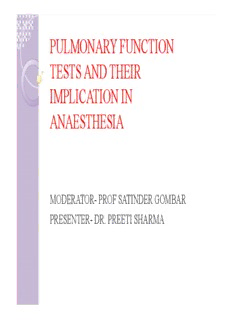
pulmonary function tests and their implication in anaesthesia PDF
Preview pulmonary function tests and their implication in anaesthesia
PULMONARY FUNCTION TESTS AND THEIR IMPLICATION IN ANAESTHESIA MODERATOR- PROF SATINDER GOMBAR PRESENTER- DR. PREETI SHARMA INTRODUCTION Pulmonary function tests is a generic term used to indicate a battery of studies or maneuvers that may be performed using standardized equipment to measure lung function. Evaluates one or more aspects of the respiratory system Respiratory mechanics Lung parenchymal function/ Gas exchange Cardiopulmonary interaction INDICATIONS DIAGNOSTIC PROGNOSTIC Evaluation of signs & symptoms- Assess severity breathlessness, chronic cough, exertional dyspnea Screening at risk pts Follow response to therapy Measure the effect of drugs on Determine further treatment goals pulmonary function To assess preoperative risk Evaluating degree of disability Monitor pulmonary drug toxicity Tisi GUIDELINES Age > 70 Obese patients Thoracic surgery Upper abdominal surgery History of cough/ smoking Any pulmonary disease American College of Physicians Guidelines Lung resection H/o smoking, dyspnoea Cardiac surgery Upper abdominal surgery Lower abdominal surgery Uncharacterized pulmonary disease(defined as history of pulmonary Disease or symptoms and no PFT in last 60 days) Contraindications Recent eye surgery Thoracic , abdominal and cerebral aneurysms Active hemoptysis Pneumothorax Unstable angina/ recent MI within 1 month INDEX Categorization of PFT’s 1. Bedside pulmonary function tests 2. Static lung volumes and capacities 3. Measurement of FRC, RV 4. Dynamic lung volumes/forced spirometry 5. Flow volume loops and detection of airway obstruction 6. Flow volume loop and lung diseases 7. Tests of gas exchange function 8. Tests for cardiopulmonary reserve 9. Preoperative assessment of thoracotomy patients 10. CATEGORIZATION OF PFT MECHANICAL VENTILATORY FUNCTIONS OF LUNG / CHEST WALL : • BED SIDE PULMONARY FUNCTION TESTS • STATIC LUNG VOLUMES & CAPACITIES – VC, IC, IRV, ERV, RV, FRC. • DYNAMIC LUNG VOLUMES –FVC, FEV1, FEF 25-75%, PEFR, MVV, RESP. MUSCLE STRENGTH GAS- EXCHANGE TESTS : • A)Alveolar-arterial po gradient 2 • B) Diffusion capacity • C) Gas distribution tests- 1)single breath N 2 test.2)Multiple Breath N test 3) Helium dilution 2 method 4) Radio Xe scinitigram. CARDIOPULMONARY INTERACTION: • Qualitative tests: 1) History , examination 2) ABG • Quantitative tests 1) 6 min walk test 2) Stair climbing test 3)Shuttle walk 4) CPET(cardiopulmonary exercise testing)
Description: